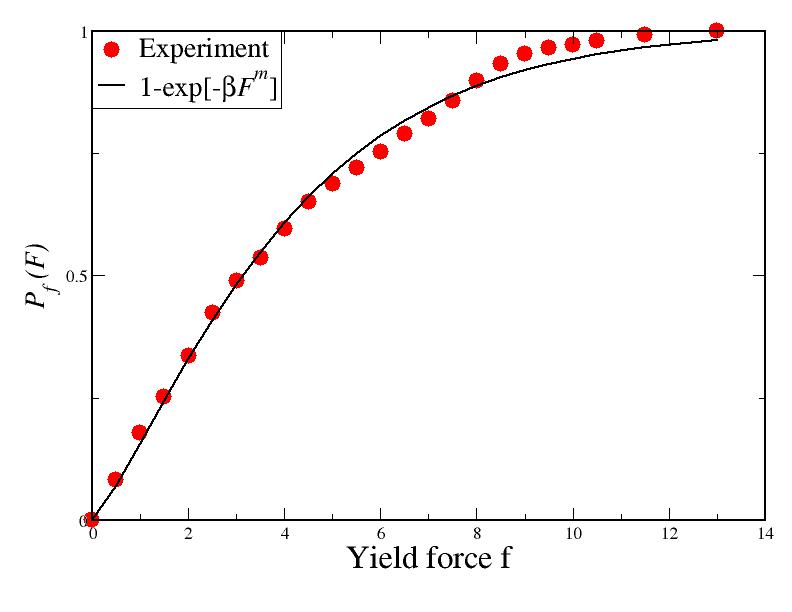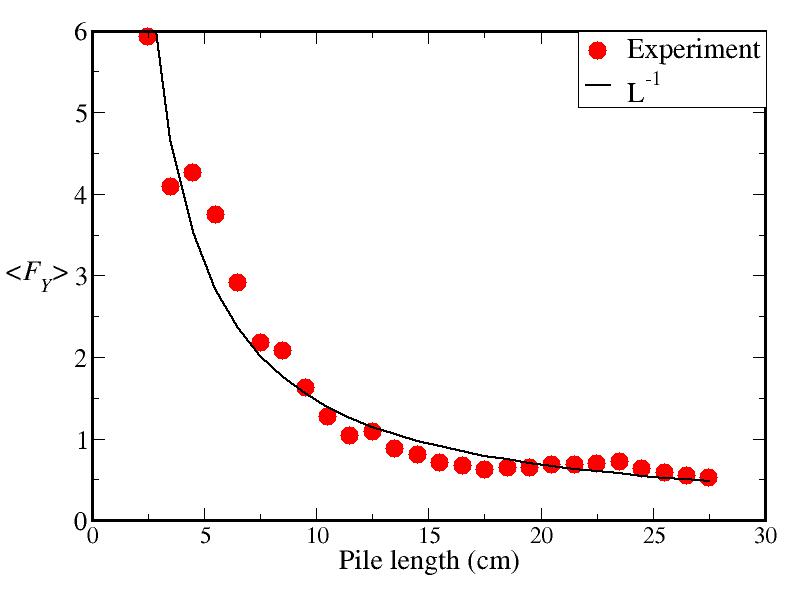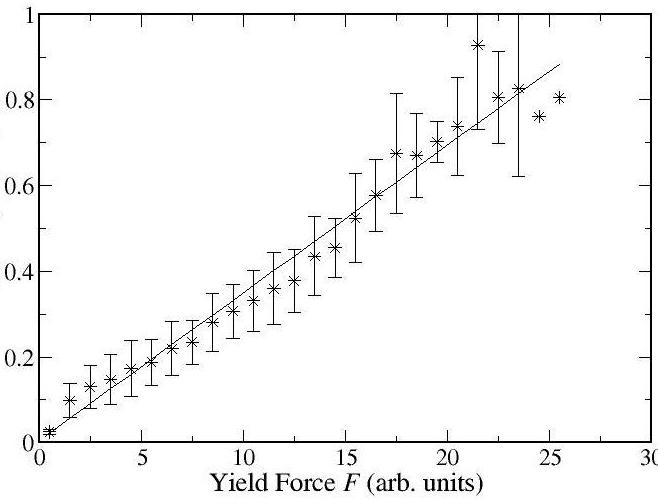58th Annual Report on Research 2013 Under Sponsorship of the ACS Petroleum Research Fund
Reports: UR1051438-UR10: Geometrically Cohesive Granular Materials: Experiment and Simulation
Scott Victor Franklin, Rochester Institute of Technology
Weibullian "weakest link" statistics
In our experiments, a cylindrical pile of U-shaped staples is
subjected to a linear extentional stress. We detect when the applied
force drops, indicating pile elongation, and the statistics of these
events analyzed. Previously, our most intriguing finding was that
longer piles are significantly weaker than short piles (as described
in our 2012 report). This can now be explained through a Weibullian
weakest link theory as follows.
The theory assumes that long samples are comprised of N smaller units, each with a length δL, and the sample fails (breaks) if any one of the sub-units fails. The theory further assumes that the probability of failure is proportional to the length δL and scales with the applied force F as a power law with exponent m. The total probability S that a sample of total length L does not fail is the product of N individual probabilities for success: S=∏[1-FmδL]. Taking the logarithm of each side and keeping terms to highest order results in the approximation that S ≈ exp[-LFm] and that the two-dimensional probability distribution of failure as a function of both applied force F and sample length L is Pf (F,L) = 1 - exp[-LFm].
If the pile length is held constant, the theory predicts a failure
probability that goes as 1-exp[-Fm]. A plot of
experimental data at fixed L is shown in Figure 1; the solid
line is the best fit of the form 1-exp[-Fm]
with m=1. The implication of m=1 is that the
probability of a fundamental length sub-unit scales linearly with the
applied force.

Figure 1: Probability
distribution Pf of failure events as a function of
applied force f. There is good agreement between experimental
data (red dots) and theoretical prediction (solid line) with a single
fit parameter, the scaling exponent m. The theory therefore
implies that failure of the fundamental length "units" in these
systems scales linearly with force.
With the scaling exponent from the fixed-length measurements, we may
now make two predictions to further test the theory's applicability.
The first is the mean yield force as a function of sample length.
This is obtained by integrating the two-dimensional probability
distribution over all lengths:
<FY>=∫ LF exp[-LF] dF ∼ L-1.
As seen in Fig. 2, the prediction of mean force agrees quite well with
the experimentally observed data.

Figure 2: Comparison of experiment and theory for mean yield force as a function of sample length. Theory predicts a simple inverse decay, the exponent having been derived from measurements on yielding at a single length. The fit is the first confirmation that weakest-link statistics apply to elongation of cohesive granular materials.
We emphasize again that a measurement taken at a single length has now been used to predict mean failure probabilities at multiple lengths.
Finally, the entire corpus of data, consisting of over 7500 individual
slip events, may be collapsed onto a single master curve. The
functional form of the master curve is a bit unwieldy, involving the
normalized 2-d probability distribution function, but in simplest form
it predicts
that L-1log[1-Pf(F,L)/Pf(L)]
∝ F. This is shown in Figure 3; within the standard-deviation
error bars, the fit is excellent. The collapse of all the data onto
this master curve confirms the applicability of the Weibullian
weakest-link theory.

Figure 3: Collapse of the 2-d failure probability distribution function (over 7500 independent yield events) onto a single master curve as predicted by Weibullian weakest-link theory.
Subsequent work will disentangle the statistics of events that occur before and after the single largest rearrangement, testing the assumption that all events may be treated as independent. The Weibullian theory also makes predictions about how yield forces should scale with changes in cross-sectional area and also in response to bending forces.
Computational work
A collaboration with Steve Teitel at the University of Rochester was
initiated. Steve's previous work has involved simulations of 2-d
round, frictionless particles under shear. We have developed code,
parallelized to run on a GPU, for 2-d U-shaped particles under shear
and are investigating the shear modulus and response of the pile to
various imposed strain-rates.
For my upcoming sabbatical year, I will be working at the University of Rochester to extend these simulations to 3-d samples in both shear and extensional geometries.
Copyright © 2014 American Chemical Society











